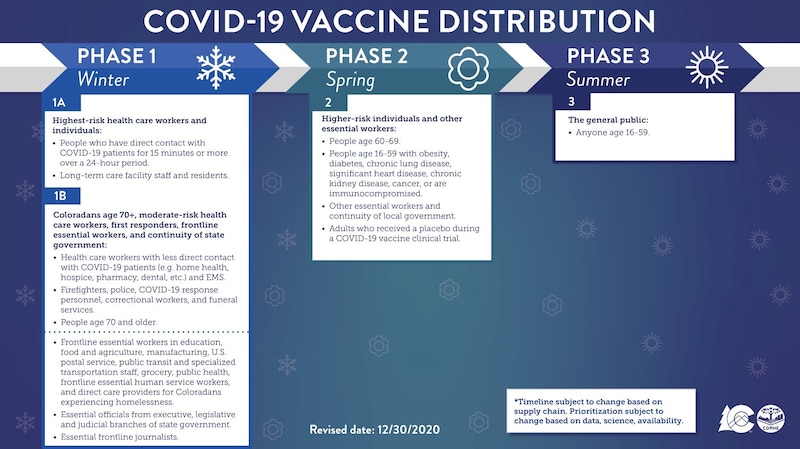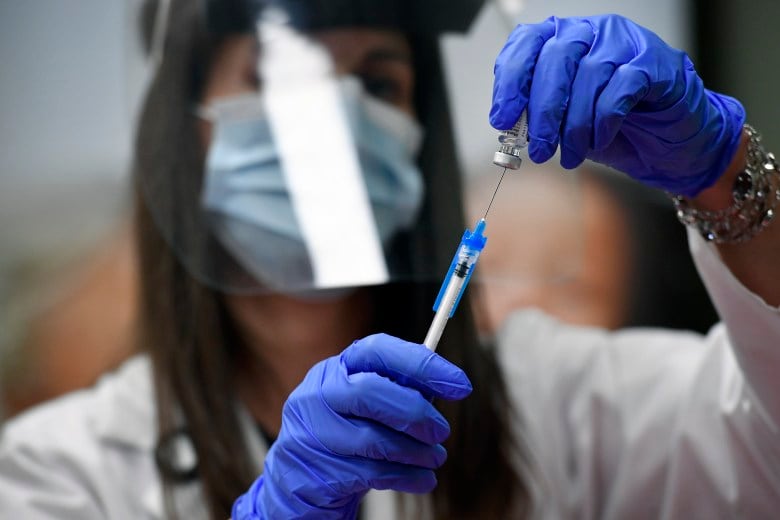Colorado teachers and school staff should have access to the COVID-19 vaccine in the early months of 2021 after Gov. Jared Polis and state public health officials moved them up on the priority list.
But it’s still not clear exactly when or how educators will get the inoculation as the new higher priority level includes more than a million people. Local public health officials said they learned of the changes on short notice and are still developing their plans.
Colorado’s previous vaccine plan put school staff and child care workers in Phase 2, ahead of the general public but at the same priority level as millions of other Coloradans, including those 65 and older and those with pre-existing conditions.
The new plan places teachers, K-12 school staff, and child care workers in Phase 1B. That tier includes people 70 and older, health care workers who don’t work directly with COVID patients, and first responders like police, firefighters, and funeral workers, followed by essential workers in a variety of sectors, including education.
Employees and instructors at higher education institutions do not have priority status.
Polis announced the change Wednesday in response to new federal Centers for Disease Control recommendations that older people and frontline essential workers get access to the vaccine after the first wave of health care workers and nursing home residents.
The change comes as the first U.S. case of a new, more contagious variant that originated in Great Britain was identified in Elbert County. The vaccine is believed to be equally effective against the new variant.
Polis said people 70 and up should be able to get the first dose of the vaccine over the next four to five weeks, depending on the flow of supply from the federal government. In recent weeks, many states, including Colorado, have received fewer doses of the vaccine than expected, and public health experts have criticized lack of coordination at the federal level for slowing the vaccine rollout.

The vaccines currently in use require two doses taken three to four weeks apart.
Polis said local public health departments would work with employers to set up site-based vaccination clinics for people who have priority due to their jobs, but it’s not clear how different groups within Phase 1B will be prioritized. A spokeswoman for the governor’s office said school staff and child care workers should be able to get vaccinated in February and March and that next steps will be determined by local public health agencies.
Boulder County Public Health tweeted Wednesday that officials there had learned of the “large Phase 1B addition” the same day as the general public and were updating their plans as quickly as possible.
“As you know, the vaccine is still limited, so it will take many months for us to be able to complete Phase 1 of vaccination,” Boulder County Public Health spokeswoman Chana Goussetis told the Denver Post.
Meagan Hillman, public health director for Prowers and Kiowa Counties and the president of the board of the Colorado Association of Local Public Health Officials, told Colorado Public Radio that many local public health agencies were in a similar position.
“We have had little time to plan for these changes,” Hillman said. “The message from the governor today implied that one can come on in and get vaccinated. We need a little bit of time to plan and to make sure that those in Tier 1A (frontline medical workers and nursing home residents and staff) have had the opportunity to receive the vaccine.”
State public health officials said they expect to finish vaccinating most people in Phase 1A by Jan. 15. Since mid-December, the state has administered more than 91,000 doses of the vaccine, mostly to frontline health care workers.
People with pre-existing conditions and people aged 65 to 69 remain in Phase 2. The general public falls into Phase 3 and likely won’t be able to be vaccinated until summer.
The vaccine has not yet been adequately tested on children and is not authorized for use in children younger than 16.
Many education advocates called for teachers to be moved up to ease a return to in-person learning, even as Polis asserted that schools are relatively safe regardless of vaccination efforts. The majority of Colorado students have been learning remotely since November after a surge in cases led to widespread quarantines that crippled school operations. November also saw an increase in school-based outbreaks.
After new restrictions were put in place in late November, cases declined significantly, though they remain elevated in parts of the state and well above levels in August.
Many school districts plan to open school buildings in January, but public health officials are also watching for a post-holiday surge. School administrators have said that it is much more challenging to keep schools open when cases are above 500 per 100,000 people over a two-week period.
In addition to giving teachers more confidence that they are safe teaching in the classroom, school officials hope that widespread vaccination will reduce the number of people who have to quarantine due to exposure.
Update: This story has been changed to reflect new information, including that local public health agencies are still developing plans for the changes to the vaccine rollout announced by Gov. Jared Polis.







